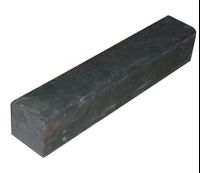close die forging parts
-
Supplier: Qingdao Go Far Mechanical Products Co.,Ltd. -
Region: Shandong, China -
Contact: Mr Rachel Guo -
Price: $15.00 / >=100 pieces -
Min. Order: 100 pieces
1. Technology
(1) Technology Introduction
Forging is a manufacturing process involving the shaping of metal using localized compressive forces. The blows are delivered with a hammer (often a power hammer) or a die. Forging is often classified according to the temperature at which it is performed: cold forging (a type of cold working), warm forging, or hot forging (a type of hot working).
(2) Process Parameters
Technical Parameters
Cast weight: 0.05kg to 20kgs
Cast size: 500 mm x 500 mm x 500 mm
Capacity: 5000 Tons/Year
Testing Facility: Chemical, Mechanical, NDT, Hydro, Hardness, Micro Structure and General Inspection
Surface treatment: Nickel Plating. Chrome Plating, Powder Coating, Paint etc.
(3) Material Introduction
Ferrous Alloys
Low Carbon Steel (Grade # EN 1A, SAE 1020, SAE 1010 etc.)
Medium Carbon Steel (Grade # EN 8, EN 31, EN 9, SAE 1045 etc.)
High Alloy Steel (Grade # 16MnCr5, 20MnCr5, EN 19, EN 24 etc.)
Stainless Steel (Grade # SS 304, SS 310, SS 316 etc..)
Non Ferrous Alloys
Brass (Grade # Free Cutting Brass, DZR, CuZn40Pb2 etc.)
And as per customer specified materials in ASTM, DIN, BS, IS, JIS standards
2. Product Introduction
Piston is a component of reciprocating engines, reciprocating pumps, gas compressors and pneumatic cylinders, among other similar mechanisms. It is the moving component that is contained by a cylinder and is made gas-tight by piston rings.
-
Digital rail ultrasonic flaw detector/railway flaw detection device/Rai defect detection

-
2024 Railway maintenance machinery remote control rail tamping machine hydraulic tamping machine hydraulic tamping machine

-
DPG-1 Railway Special Transport Car Lithium Battery Bicycle Single Person Inspection Vehicle

-
Hydraulic gauge adjuster rail gauge adjuster

-
Railway Milling Machine Appropriate Price Railway Rail Grinder FGM Series EU IV Power Time Dimensions Weight

-
Railway clip E2056 Spring clip for railway fastening system

-
Product Supply Railway Steel Spiral Spike Railway Track Accessories

-
2019 Hot Sale YD-22 Railway Equipment Railway Press Machine

-
Factory latest plastic sleepers factory new goods plastic sleepers

-
sale railway track cutting machine track saw railway chainsaw

Other Products
-
 $25.00 / piece
$25.00 / piece -
 $25.00 / piece
$25.00 / piece -
 $5.50 / piece
$5.50 / piece -
 $13.00 / piece
$13.00 / piece -
 $16.00 / piece
$16.00 / piece -
 $15.00 / piece
$15.00 / piece




















